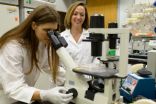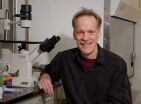(Press-News.org) Berlin, Germany (November, 2014) - Sweating, panting, moving to the shade, or taking a dip are all time-honored methods used by animals to cool down. The implicit goal of these adaptations is always to keep the brain from overheating. Now a new study shows that armor-plated dinosaurs (ankylosaurs) had the capacity to modify the temperature of the air they breathed in an exceptional way: by using their long, winding nasal passages as heat transfer devices.
Led by paleontologist Jason Bourke, a team of scientists at Ohio University used CT scans to document the anatomy of nasal passages in two different ankylosaur species. The team then modeled airflow through 3D reconstructions of these tubes. Bourke found that the convoluted passageways would have given the inhaled air more time and more surface area to warm up to body temperature by drawing heat away from nearby blood vessels. As a result, the blood would be cooled, and shunted to the brain to keep its temperature stable.
Modern mammals and birds use scroll-shaped bones called conchae or turbinates to warm inhaled air. But ankylosaurs seem to have accomplished the same result with a completely different anatomical construction.
"There are two ways that animal noses transfer heat while breathing," says Bourke. "One is to pack a bunch of conchae into the air field, like most mammals and birds do--it's spatially efficient. The other option is to do what lizards and crocodiles do and simply make the nasal airway much longer. Ankylosaurs took the second approach to the extreme."
Lawrence Witmer, who was also involved with the study, said, "Our team discovered these 'crazy-straw' airways several years ago, but only recently have we been able to scientifically test hypotheses on how they functioned. By simulating airflow through these noses, we found that these stretched airways were effective heat exchangers. They would have allowed these multi-tonne beasts to keep their multi-ounce brains from overheating."
Like our own noses, ankylosaur noses likely served more than one function. Even as it was conditioning the air it breathed, the convoluted passageways may have added resonance to the low-pitched sounds the animal uttered, allowing it to be heard over greater distances.
INFORMATION:
This research was funded by the U.S. National Science Foundation, Ohio University, the Jurassic Foundation, and Sigma Xi.
About the Society of Vertebrate Paleontology
Founded in 1940 by thirty-four paleontologists, the Society now has more than 2,300 members representing professionals, students, artists, preparators, and others interested in VP. It is organized exclusively for educational and scientific purposes, with the object of advancing the science of vertebrate paleontology.
Society of Vertebrate Paleontology website: http://www.vertpaleo.org
Journal of Vertebrate Paleontology
The Journal of Vertebrate Paleontology (JVP) is the leading journal of professional vertebrate paleontology and the flagship publication of the Society. It was founded in 1980 by Dr. Jiri Zidek and publishes contributions on all aspects of vertebrate paleontology.
Journal Web site: http://vertpaleo.org/Publications/Journal-of-Vertebrate-Paleontology.aspx
AUTHOR CONTACT INFORMATION
JASON BOURKE
Department of Biological Sciences
Ohio University
Irvine Hall
Athens, Ohio 45701
jb513009@ohio.edu
LAWRENCE WITMER
Department of Biological Sciences
Ohio University
Irvine Hall, Athens, Ohio 45701
witmerL@ohio.edu
RYAN RIDGELY
Department of Biological Sciences
Ohio University
Irvine Hall, Athens, Ohio 45701
ridgely@ohio.edu
WILLIAM RUGER PORTER
Department of Biological Sciences
Ohio University
Irvine Hall, Athens, Ohio 45701
wp298308@ohio.edu
OTHER EXPERTS NOT DIRECTLY INVOLVED WITH THE STUDY
ROBERT V. HILL, PhD
Department of Anatomy
NYIT College of Osteopathic Medicine
(516) 686-3807
rhill01@nyit.edu
A/C came standard on armored dinosaur models
2014-11-08
ELSE PRESS RELEASES FROM THIS DATE:
UF researchers discover how to cultivate norovirus in human cells
2014-11-07
GAINESVILLE, Fla. -- Noroviruses are pernicious intestinal viruses. They cause violent vomiting and diarrhea, and people ill with the virus remain contagious up to three days after they seem to recover.
Although a vaccine for these viruses is in clinical trials, there is still no medication to combat them. That's in part because researchers have not been able to culture human noroviruses so they can test potential treatments -- until now, according to a study by University of Florida Health researchers published Friday, Nov. 7 in the journal Science.
UF Health researcher ...
Practice makes perfect in cancer surgery
2014-11-07
In a new, in-depth research project, Queen's professors Rob Siemens (Urology) and Christopher Booth (Cancer Care and Epidemiology) investigated what affect higher volume hospitals and surgeons had on the outcomes of patients undergoing a radical cystectomy for bladder cancer in Ontario.
Using data provided by the Institute for Clinical Evaluative Sciences (ICES) the investigators studied 2,802 patients who underwent the procedure between 1994 and 2008 in Ontario and found that higher volume hospital and surgeons were associated with less post-operative complications and ...
Preschoolers eat healthy when parents set rules about food, UB study finds
2014-11-07
BUFFALO, N.Y. -- Preschoolers whose parents have rules about what their children can and cannot eat have healthier eating habits than those raised without such rules, according to a new study by pediatrics researchers at the University at Buffalo.
The study also provides new information on how toddlers' ability to self-regulate, or control, their emotional and behavioral impulses influences their eating habits two years later, depending on the presence or absence of parental food rules.
The research is being presented on Nov. 7 at ObesityWeek 2014 in Boston. ObesityWeek ...
Iodide protects against dangerous reperfusion injury after heart attack
2014-11-07
As if having a heart attack isn't bad enough, cardiologists know that the worst damage may actually occur after it's over.
Blocked arteries are typically the trigger, stopping the flow of blood and starving the heart muscle of oxygen. But when the blockage is removed and the blood comes rushing back, it wreaks havoc of its own. The result is called reperfusion injury, a life-threatening flood of inflammation and cellular destruction that has stumped scientists for 40 years.
Now, however, a potentially groundbreaking study by Fred Hutchinson Cancer Research Center scientists, ...
UTSA professor studies cell phone habits of college students in US and South Korea
2014-11-07
Seok Kang, associate professor in the UTSA Department of Communication, collaborated with Korean researcher Jaemin Jung to study the smartphone habits of college students in the United States and South Korea. The researchers were particularly interested in the type and amount of information college students from both countries disclose. The study was published in Computers in Human Behavior.
The two countries were selected due to the high rates of smartphone ownership among their young adults. Eighty percent of Americans own smartphones while the ownership rate in Korea ...
CCNY-led discovery may help breast cancer treatment
2014-11-07
Researchers led by Dr. Debra Auguste, associate professor, biomedical engineering, in the Grove School of Engineering at The City College of New York, have identified a molecule that could lead to developing treatment for one of the most aggressive forms of breast cancer.
Triple negative breast cancers (TNBCs) have a high mortality rate owing to aggressive proliferation and metastasis and a lack of effective therapeutic options. However, Professor Auguste's team, discovered the overexpression of intercellular adhesion molecule-1 (ICAM-1) in human TNBC cell lines and tissues, ...
Office stress? Workers may wait before acting out, SF State study finds
2014-11-07
Employers know that dramatic changes in the workplace, such as the start of the "busy season" or a new, more demanding boss, can cause employees to act out in ways that hurt the bottom line. But a new study suggests that companies may be underestimating the impact of such behavior because they assume it only happens immediately after a stressful change.
The research from SF State organizational psychologist Kevin Eschleman shows that many employees wait weeks or months before engaging in "counterproductive work behaviors," like taking a longer lunch or stealing office ...
Mars spacecraft, including MAVEN, reveal comet flyby effects on Martian atmosphere
2014-11-07
Two NASA and one European spacecraft, including NASA's MAVEN mission led by the University of Colorado Boulder, have gathered new information about the basic properties of a wayward comet that buzzed by Mars Oct. 19, directly detecting its effects on the Martian atmosphere.
Data from observations carried out by MAVEN, NASA's Mars Reconnaissance Orbiter (MRO) and the European Space Agency's Mars Express spacecraft revealed that debris from the comet, known officially as Comet C/2013 A1 Siding Spring, caused an intense meteor shower and added a new layer of ions, or charged ...
NFL TV ratings: Bandwagon is everyone's second-favorite team
2014-11-07
A new study by Brigham Young University and the Fox affiliate in Salt Lake City shows that choosing to broadcast a local favorite isn't always the smartest ratings decision.
The new study shows how TV execs should decide which games to air when the home-town team isn't playing - or in markets like Utah that don't have their own team. Traditionally the most popular teams in Utah have been the Broncos, Cowboys and 49ers.
"When you look at the difference between the average team effect, like say the Miami Dolphins, and the next top tier after the Denver Broncos, the results ...
Reprogrammed cells grow into new blood vessels
2014-11-07
HOUSTON -- ( Nov. 7, 2014 ) -- By transforming human scar cells into blood vessel cells, scientists at Houston Methodist may have discovered a new way to repair damaged tissue. The method, described in an upcoming issue of Circulation (early online), appeared to improve blood flow, oxygenation, and nutrition to areas in need.
Cardiovascular scientists at Houston Methodist, with colleagues at Stanford University and Cincinnati Children's Hospital, learned that fibroblasts -- cells that causes scarring and are plentiful throughout the human body -- can be coaxed into becoming ...





